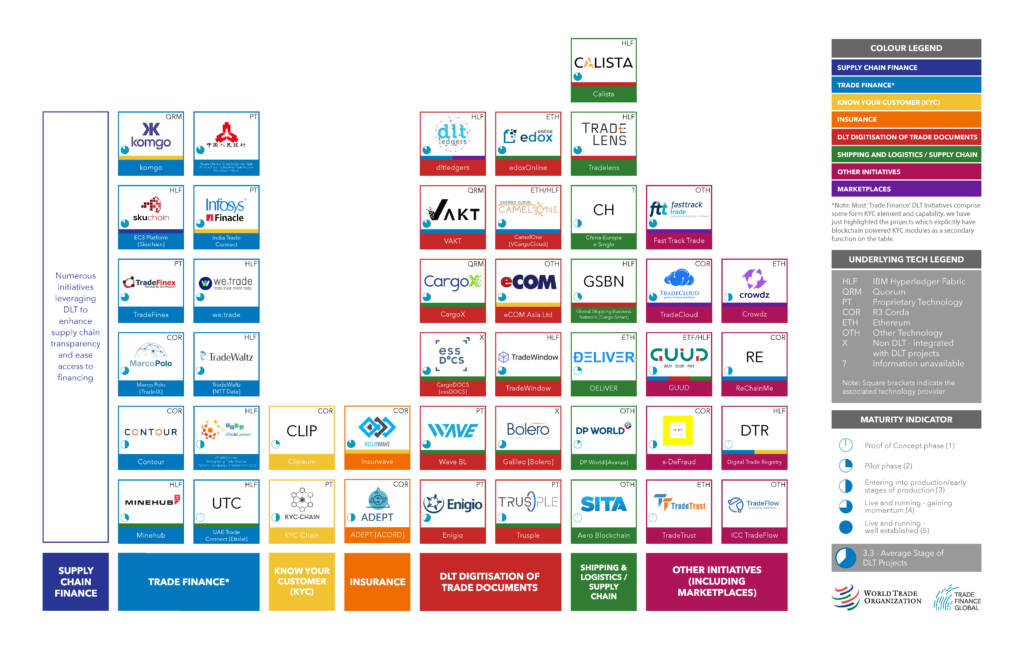Irish company Marco Polo Network Operations (Ireland) Limited has been appointed to administrators following a court ruling declaring the company insolvent on Wednesday, 22 February.
According to the Irish Times, Marco Polo Network intended to close a strategic $12 million (£10 million) deal with Bank of America, which fell through.
The court ruling on 22 February heard that the Marco Polo Network has debts of more than €5.2 million (£4.6 million) and its current liabilities exceed the total value of assets by €2.5 million (£2.2 million).
The Marco Polo Network claims a significant investment into developing a product to replace Bank of America’s own internal account automation service, an important step in Bank of America’s investment, the court ruling heard.
Just 9 months after the collapse of we.trade, along with Serai, HSBC backed blockchain-based trade platform, serious questions continue to be raised around the commercial viability.
In the previous TFG article 6 lessons from the tradetech industry, former Marco Polo Network director Daniel Cotti told TFG: “Five years ago, it was all about technology and blockchain. We have learned that technology is an enabler through which you can offer services and connect with partners and clients, but it is not the sole driver for a successful business.
Though many industry actors thought blockchain would be the holy grail of the trade finance industry, this proved not to be the case. What actually counts are well-designed and well-thought-out value propositions that solve real day-to-day corporate problems.”

The Marco Polo Network, founded in 2017, was a blockchain-based platform aiming to streamline and simplify global trade finance processes.
It was a collaboration between technology firm TradeIX and enterprise software company R3, utilizing R3’s Corda blockchain technology to enable secure and efficient communication and data exchange between different parties involved in international trade transactions, primarily open account finance.
The network allowed banks and financial institutions, corporates, and third-party service providers to share and exchange trade data in real-time, improving the transparency and efficiency of trade finance processes.
By utilising blockchain technology, the Marco Polo Network also aimed to reduce the risk of fraud and errors in trade finance by providing a single, tamper-proof source of truth for all parties involved.
Some of the key features of the Marco Polo Network include the ability to track and manage trade transactions from end to end, automate the process of trade finance through smart contracts, and provide real-time visibility into trade data and financing options.
The Marco Polo Network operates following a license and transaction fee model.
Andre Casterman, managing director, Casterman Advisory and fintech board member, International Trade & Forfaiting Association (ITFA), told TFG:
“Collaborative innovations in trade finance are the most complex to get off the ground. The only way to succeed is to focus on specific functions or processes and embed those into the trade and trade finance ecosystems.
The [Marco Polo] situation is not the first and will not be the last one. Focusing on one segment, or one function to bring the most specialised value proposition is my only advice to those entering the trade space. Don’t try to change what’s working pretty fine. The incremental value risks to be too low.
This has been my approach when I set up both DNI Initiative and TFD Initiative – respectively with Enigio and Tradeteq. We focus on adding new differentiating value. We avoid changing practices systems and channels, rather we add new highly specialised Tradetech components for the market to take advantage of. At this stage, the recipe works very well and many stakeholders are benefiting.”
Video: TFG heard Cyril Broutin, Account Delivery Executive at Trade IX and Eric Henry, Head of Innovation, Trade Finance & Supply Chain at BNP Paribas, about the banking ecosystems in the Marco Polo Network at Sibos, 2019. Watch now
To date, the Marco Polo Network claimed many proof of concept transactions. Using this proof of concept programme, Sumitomo Mitsui Banking Corporation (SMBC) completed a receivables finance and payment commitment transaction in 2019. Furthermore, in 2021 Marco Polo executed an accounts receivable discounting transaction with a Japanese corporate client.
In an effort to expand into the Americas, Marco Polo completed a transaction with Servilamina Summit Mexicana, providing a receivables discount programme.
The Marco Polo Network claims it employed 91 people, operating as three subsidiaries in the UK, US and Singapore.
In January 2023, Marco Polo Network appointed Griff Williams and Matt Burns as Sales Directors of the US and Europe respectively and announced Jonathan Conway’s role as CTO from October 2022.
According to Companies House data, Marco Polo Business Network Limited, its UK subsidiary previously trading as TradeIX Limited, terminated the appointments of directors Richard Tynan (on 9 February 2023), Daniel Cotti (on 18 August 2022), Robert Barnes (on 31 March 2021) and Christen Sveaas (on 31 March 2021).
Why are blockchain tradetechs facing so many challenges?
There are several reasons why blockchain-based trade technology companies are struggling in the market:
- Lack of adoption: One of the biggest challenges for blockchain-based trade technology companies is the lack of adoption. Despite the potential benefits of blockchain technology, many companies are hesitant to adopt it because it requires significant changes in their existing systems and processes. This reluctance to adopt new technology can make it difficult for blockchain-based trade technology companies to gain traction in the market.
- Regulatory uncertainty: Another challenge facing blockchain-based trade technology companies is regulatory uncertainty. Governments and regulatory bodies around the world are still trying to figure out how to regulate blockchain technology, which can create uncertainty for companies operating in this space. This uncertainty can make it difficult for companies to secure funding and grow their business. The Marco Polo Network court ruling also claimed that Bank of America had reticence around blockchain investments following the FTX collapse.
- Limited scalability: Another issue with blockchain technology is limited scalability. Current blockchain systems can only handle a limited number of transactions per second, which can be a bottleneck for companies that need to process a high volume of transactions. This limitation can make it difficult for blockchain-based trade technology companies to compete with traditional systems that can process a much higher volume of transactions.
- High costs: Developing and implementing blockchain-based trade technology can be expensive. This can make it difficult for startups and small businesses to enter the market and compete with larger, more established companies. In addition, the cost of running a blockchain network can be high, which can be a barrier to entry for companies that are trying to operate on a tight budget.
- Lack of interoperability: Finally, another challenge facing blockchain-based trade technology companies is the lack of interoperability between different blockchain networks. This can make it difficult for companies to work together and share data, which can limit the potential benefits of blockchain technology. Until there is greater interoperability between different blockchain networks, it may be difficult for blockchain-based trade technology companies to gain widespread adoption.

Blockchain for trade finance – periodic table
The Trade Finance Global (TFG), World Trade Organization (WTO) and International Chamber of Commerce (ICC) periodic table for blockchain and trade finance is a visual representation of the different blockchain-based solutions that are being developed to address challenges in trade finance. The table is modeled after the periodic table of elements, with each “element” representing a different blockchain-based solution.
The TFG periodic table provides a useful framework for understanding the different types of blockchain-based solutions that are being developed for trade finance, and how they fit together to create a comprehensive ecosystem for blockchain-based trade finance.
View the table here: https://www.tradefinanceglobal.com/blockchain/periodic-table/.
 Australia
Australia Hong Kong
Hong Kong Japan
Japan Singapore
Singapore United Arab Emirates
United Arab Emirates United States
United States France
France Germany
Germany Ireland
Ireland Netherlands
Netherlands United Kingdom
United Kingdom












Comments are closed.